Optical Force of Bessel Pincer Light-Sheets Beam on a Dielectric Sphere of Arbitrary Size
Abstract
1. Introduction
2. Methods
2.1. Angular of Bessel Pincer Light-Sheets Beam
2.2. Optical Force on a Sphere
3. Results
3.1. Numerical Validation
3.1.1. Incident Intensity
3.1.2. Force Component of and
3.2. Longitudinal and Transverse Optical Force and
3.2.1. Different Radius of the Particle
3.2.2. Different Beam Scaling Parameter of Bessel Pincer Light-Sheets Beam
3.2.3. Different Beam Order l of Bessel Pincer Light-Sheets Beam
3.2.4. Different Refractive Indices of the Particle
3.3. and versus the Dimensionless Parameter
4. Conclusions
Author Contributions
Funding
Data Availability Statement
Conflicts of Interest
Abbreviations
| GLMT | Genralized Lorenz Mie Theory |
References
- Dholakia, K.; Reece, P. Optical micromanipulation takes hold. Nano Today 2006, 1, 18–27. [Google Scholar] [CrossRef]
- Chen, J.; Ng, J.; Lin, Z.; Chan, C.T. Optical pulling force. Nat. Photonics 2011, 5, 531–534. [Google Scholar] [CrossRef]
- Karásek, V.; Čižmár, T.; Brzobohatý, O.; Zemánek, P.; Garcés-Chávez, V.; Dholakia, K. Long-range one-dimensional longitudinal optical binding. Phys. Rev. Lett. 2008, 101, 143601. [Google Scholar] [CrossRef] [PubMed]
- Yamanishi, J.; Yamane, H.; Naitoh, Y.; Li, Y.J.; Yokoshi, N.; Kameyama, T.; Sugawara, Y. Optical force mapping at the single-nanometre scale. Nat. Commun. 2021, 12, 3865. [Google Scholar] [CrossRef]
- Huang, C.H.; Louis, B.; Bresolí-Obach, R.; Kudo, T.; Camacho, R.; Scheblykin, I.G.; Masuhara, H. The primeval optical evolving matter by optical binding inside and outside the photon beam. Nat. Commun. 2022, 13, 5325. [Google Scholar] [CrossRef]
- Zhong, M.C.; Wei, X.B.; Zhou, J.H.; Wang, Z.Q.; Li, Y.M. Trapping red blood cells in living animals using optical tweezers. Nat. Commun. 2013, 4, 1768. [Google Scholar] [CrossRef]
- Ge, J.; Bian, X.; Ma, L.; Cai, Y.; Li, Y.; Yang, J.; Zhang, Y. Stepwise membrane binding of extended synaptotagmins revealed by optical tweezers. Nat. Chem. Biol. 2022, 18, 313–320. [Google Scholar] [CrossRef] [PubMed]
- Pochitaloff, M.; Miranda, M.; Richard, M.; Chaiyasitdhi, A.; Takagi, Y.; Cao, W.; Martin, P. Flagella-like beating of actin bundles driven by self-organized myosin waves. Nat. Phys. 2022, 18, 1240–1247. [Google Scholar] [CrossRef]
- Das, S.; Butenko, A.V.; Mastai, Y.; Deutsch, M.; Sloutskin, E. Topology-driven surface patterning of liquid spheres. Nat. Phys. 2022, 18, 1177–1180. [Google Scholar] [CrossRef]
- Swartzlander, G.A.; Peterson, T.J.; Artusio-Glimpse, A.B.; Raisanen, A.D. Stable optical lift. Nat. Photonics 2011, 5, 48–51. [Google Scholar] [CrossRef]
- Simpson, S.H.; Hanna, S.; Peterson, T.J.; Swartzlander, G.A. Optical lift from dielectric semicylinders. Opt. Lett. 2012, 37, 4038–4040. [Google Scholar] [CrossRef] [PubMed]
- Rosenberg, J.; Lin, Q.; Painter, O. Static and dynamic wavelength routing via the gradient optical force. Nat. Photonics 2009, 3, 478–483. [Google Scholar] [CrossRef]
- Liang, H.; Wright, W.H.; Cheng, S.; He, W.; Berns, M.W. Micromanipulation of chromosomes in PTK2 cells using laser microsurgery (optical scalpel) in combination with laser-induced optical force (optical tweezers). Exp. Cell Res. 1993, 204, 110–120. [Google Scholar] [CrossRef] [PubMed]
- Bayles, C.J.; Aist, J.R.; Berns, M.W. The mechanics of anaphase B in a basidiomycete as revealed by laser microbeam microsurgery. Exp. Mycol. 1993, 17, 191–199. [Google Scholar] [CrossRef][Green Version]
- Fuhr, G.; Reichle, C.; Müller, T.; Kahlke, K.; Schütze, K.; Stuke, M. Processing of micro-particles by UV laser irradiation in a field cage. Appl. Phys. A 1999, 69, 611–616. [Google Scholar] [CrossRef]
- Jarvis, J.; Lebedev, V.; Romanov, A.; Broemmelsiek, D.; Carlson, K.; Chattopadhyay, S.; Valishev, A. Experimental demonstration of optical stochastic cooling. Nature 2022, 608, 287–292. [Google Scholar] [CrossRef] [PubMed]
- Peschel, M.T.; Högner, M.; Buberl, T.; Keefer, D.; de Vivie-Riedle, R.; Pupeza, I. Sub-optical-cycle light-matter energy transfer in molecular vibrational spectroscopy. Nat. Commun. 2022, 13, 5897. [Google Scholar] [CrossRef] [PubMed]
- Yin, P.; Li, R.; Yin, C.; Xu, X.; Bian, X.; Xie, H.; Du, J. Experiments with levitated force sensor challenge theories of dark energy. Nat. Phys. 2022, 18, 1181–1185. [Google Scholar] [CrossRef]
- Peddireddy, K.R.; Clairmont, R.; Neill, P.; McGorty, R.; Robertson-Anderson, R.M. Optical-Tweezers-integrating-Differential-Dynamic-Microscopy maps the spatiotemporal propagation of nonlinear strains in polymer blends and composites. Nat. Commun. 2022, 13, 5180. [Google Scholar] [CrossRef]
- Chaudhuri, O.; Parekh, S.H.; Lam, W.A.; Fletcher, D.A. Combined atomic force microscopy and side-view optical imaging for mechanical studies of cells. Nat. Methods. 2009, 6, 383–387. [Google Scholar] [CrossRef]
- Phillips, D.B.; Padgett, M.J.; Hanna, S.; Ho, Y.L.D.; Carberry, D.M.; Miles, M.J.; Simpson, S.H. Shape-induced force fields in optical trapping. Photonics 2014, 8, 400–405. [Google Scholar] [CrossRef]
- Lebedew, P. Untersuchungen über die Druckkräfte des Lichtes. Ann. Phys. 1901, 311, 433–458. [Google Scholar] [CrossRef]
- Lebedev, P.N. LEBEDEV 1901. Ann. Phys. 1901, 6, 433. [Google Scholar]
- Hull, G.F.; Bell, M.; Green, S.E. Notes on the Pressure of Radiation. Proc. Phys. Soc. 1934, 46, 589. [Google Scholar] [CrossRef]
- Ashkin, A. Acceleration and trapping of particles by radiation pressure. Phys. Rev. Lett. 1970, 24, 156. [Google Scholar] [CrossRef]
- Ashkin, A.; Dziedzic, J.; Yamane, T. Optical trapping and manipulation of single cells using infrared laser beams. Nature 1987, 330, 769–771. [Google Scholar] [CrossRef] [PubMed]
- Gordon, J.P. Radiation forces and momenta in dielectric media. Phys. Rev. A 1973, 8, 14. [Google Scholar] [CrossRef]
- Purcell, E.M.; Pennypacker, C.R. Scattering and absorption of light by nonspherical dielectric grains. Astrophys. J. 1973, 186, 705–714. [Google Scholar] [CrossRef]
- Volpe, G.; Helden, L.; Brettschneider, T.; Wehr, J.; Bechinger, C. Influence of noise on force measurements. Phys. Rev. Lett. 2010, 104, 2010. [Google Scholar] [CrossRef] [PubMed]
- Yurkin, M.A.; Hoekstra, A.G. The discrete-dipole-approximation code ADDA: Capabilities and known limitations. J. Quant. Spectrosc. Radiat. Transfer. 2011, 112, 2234–2247. [Google Scholar] [CrossRef]
- Wei, B.; Li, R.; Zhang, S.; Zhang, J.; Xu, Q.; Song, N.; Sun, H. Photonic jet generated by a dielectric ellipsoidal particle. J. Quant. Spectrosc. Radiat. Transfer. 2020, 242, 106786. [Google Scholar] [CrossRef]
- Zhang, S.; Li, R. Proceedings of the 2019 IEEE International Conference on Computational Electromagnetics (ICCEM), Shanghai, China, 20–22 March 2019.
- Mie, G. Beiträge zur Optik trüber Medien, speziell kolloidaler Metallösungen. Ann. Phys. 1908, 330, 377–445. [Google Scholar] [CrossRef]
- Casperson, L.W.; Yeh, C. Rayleigh-Debye scattering with focused laser beams. Ann. Phys. 1978, 17, 1637–1643. [Google Scholar] [CrossRef]
- Kim, J.S.; Lee, S.S. Scattering of laser beams and the optical potential well for a homogeneous sphere. J. Opt. Soc. Am. 1983, 73, 303–312. [Google Scholar] [CrossRef]
- Gouesbet, G.; Maheu, B.; Gréhan, G. Light scattering from a sphere arbitrarily located in a Gaussian beam, using a Bromwich formulation. J. Opt. Soc. Am. 1988, 5, 1427–1443. [Google Scholar] [CrossRef]
- Barton, J.P.; Alexander, D.R.; Schaub, S.A. Internal and near-surface electromagnetic fields for a spherical particle irradiated by a focused laser beam. J. Appl. Phys. 1988, 64, 1632–1639. [Google Scholar] [CrossRef]
- Barton, J.P.; Alexander, D.R.; Schaub, S.A. Theoretical determination of net radiation force and torque for a spherical particle illuminated by a focused laser beam. J. Appl. Phys. 1989, 66, 4594–4602. [Google Scholar] [CrossRef]
- Brevik, I. Experiments in phenomenological electrodynamics and the electromagnetic energy-momentum tensor. J. Phys. Rep. 1979, 52, 133–201. [Google Scholar] [CrossRef]
- Scott, W.T. Electromagnetism (Oxford Physics Series) by FNH Robinson. Reviewer 1976, 611–616. [Google Scholar]
- Mitri, F.G. Radiation force and torque of light-sheets. J. Opt. 2017, 19, 065403. [Google Scholar] [CrossRef]
- Li, R.; Shi, L.; Ren, K.F.; Jiang, H. Debye series for Gaussian beam scattering by a multilayered sphere. Appl. Opt. 2007, 46, 4804–4812. [Google Scholar] [CrossRef] [PubMed]
- Gašparić, V.; Mayerhöfer, T.G.; Zopf, D.; Ristić, D.; Popp, J.; Ivanda, M. To generate a photonic nanojet outside a high refractive index microsphere illuminated by a Gaussian beam. Opt. Lett. 2022, 47, 2534–2537. [Google Scholar] [CrossRef] [PubMed]
- Yang, R.; Li, R. Optical force exerted on a Rayleigh particle by a vector arbitrary-order Bessel beam. J. Quant. Spectrosc. Radiat. Transfer. 2016, 178, 230–243. [Google Scholar] [CrossRef]
- Li, X.; Chen, J.; Lin, Z.; Ng, J. Optical pulling at macroscopic distances. Sci. Adv. 2019, 5, eaau7814. [Google Scholar] [CrossRef]
- Fan, X.D.; Zhang, L. Trapping force of acoustical Bessel beams on a sphere and stable tractor beams. Phys. Rev. Appl. 2019, 11, 014055. [Google Scholar] [CrossRef]
- Berry, M.V.; Balazs, N.L. Nonspreading wave packets. Am. J. Phys. 1979, 47, 264–267. [Google Scholar] [CrossRef]
- Zhang, S.; Li, R.; Wei, B.; Zhang, J.; Sun, H.; Song, N. Scattering of a non-paraxial Bessel light-sheet by a sphere of arbitrary size. Opt. Express. 2020, 245, 106869. [Google Scholar] [CrossRef]
- Durnin, J.; Miceli, J.J., Jr.; Eberly, J.H. Diffraction-free beams. Phys. Rev. Lett. 1987, 58, 1499. [Google Scholar] [CrossRef]
- Zhao, Z.; Zang, W.; Tian, J. Optical trapping and manipulation of Mie particles with Airy beam. J. Opt. 2016, 18, 025607. [Google Scholar] [CrossRef]
- Baumgartl, J.; Mazilu, M.; Dholakia, K. Optically mediated particle clearing using Airy wavepackets. Nat. Photonics 2008, 2, 675–678. [Google Scholar] [CrossRef]
- Wang, M.M.; Tu, E.; Raymond, D.E.; Yang, J.M.; Zhang, H.; Hagen, N.; Dees, B.; Mercer, E.M.; Forster, A.H.; Kariv, I.; et al. Microfluidic sorting of mammalian cells by optical force switching. Nat. Biotechnol. 2005, 23, 83–87. [Google Scholar] [CrossRef] [PubMed]
- Brau, R.R.; Tarsa, P.B.; Ferrer, J.M.; Lee, P.; Lang, M.J. Interlaced optical force-fluorescence measurements for single molecule biophysics. Biophys. J. 2006, 91, 1069–1077. [Google Scholar] [CrossRef] [PubMed]
- Choi, B.; Jia, W.; Channual, J.; Kelly, K.M.; Lotfi, J. The importance of long-term monitoring to evaluate the microvascular response to light-based therapies. J. Investig. Dermatol. 2008, 128, 485. [Google Scholar] [CrossRef] [PubMed][Green Version]
- Otte, E.; Denz, C. Optical trapping gets structure: Structured light for advanced optical manipulation. Appl. Phys. Rev. 2020, 7, 041308. [Google Scholar] [CrossRef]
- Mitri, F.G. Circularly-polarized Airy light-sheet spinner tweezers and particle transport. J. Quant. Spectrosc. Radiat. Transfer. 2021, 260, 107466. [Google Scholar] [CrossRef]
- Mitri, F.G. Negative optical radiation force and spin torques on subwavelength prolate and oblate spheroids in fractional Bessel–Gauss pincers light-sheets. J. Opt. Soc. Am. A 2017, 34, 1246–1254. [Google Scholar] [CrossRef]
- Mitri, F.G. Unconventional circularly polarized Airy light-sheet spinner tweezers. J. Opt. Soc. Am. A 2021, 38, 526–533. [Google Scholar] [CrossRef]
- Zhang, S.; Li, R.; Wei, B.; Song, N.; Yang, L.; Sun, H. Scattering of a non-paraxial Bessel pincer light-sheet by a dielectric sphere of arbitrary size. J. Quant. Spectrosc. Radiat. Transfer. 2021, 268, 107647. [Google Scholar] [CrossRef]
- Mitri, F.G. Nonparaxial Bessel and Bessel—Gauss pincers light-sheets. Phys. Lett. A 2017, 381, 171–175. [Google Scholar] [CrossRef]
- Lu, W.; Chen, H.; Liu, S.; Lin, Z. Rigorous full-wave calculation of optical forces on dielectric and metallic microparticles immersed in a vector Airy beam. Opt. Express. 2017, 25, 23238–23253. [Google Scholar] [CrossRef]
- Trukhanov, S.V.; Trukhanov, A.V.; Turchenko, V.A.; Trukhanov, A.V.; Trukhanova, E.L.; Tishkevich, D.; Ivanov, V.M.; Zubar, T.I.; Salem, M.; Kostishyn, V.G.; et al. Polarization origin and iron positions in indium doped barium hexaferrites. Ceram. Int. 2018, 44, 290–300. [Google Scholar] [CrossRef]
- Kozlovskiy, A.; Kenzhina, I.; Alyamova, Z.A.; Zdorovets, M. Optical and structural properties of AlN ceramics irradiated with heavy ions. Opt. Mater. 2019, 91, 130–137. [Google Scholar] [CrossRef]
- Kozlovskiy, A.L.; Zdorovets, M.V. Effect of doping of Ce4+/3+ on optical, strength and shielding properties of (0.5-x) TeO2-0.25 MoO-0.25 Bi2O3-xCeO2 glasses. Mater. Chem. Phys. 2021, 263, 124444. [Google Scholar] [CrossRef]
- Turchenko, V.A.; Trukhanov, S.V.; Kostishin, V.G.E.; Damay, F.; Porcher, F.; Klygach, D.S.; Vakhitov, M.G.; Matzui, L.Y.; Yakovenko, O.S.; Bozzo, B.; et al. Impact of In3+ cations on structure and electromagnetic state of M-type hexaferrites. J. Energy Chem. 2022, 69, 667–676. [Google Scholar] [CrossRef]
- Kozlovskiy, A.L.; Zdorovets, M.V. Synthesis, structural, strength and corrosion properties of thin films of the type CuX (X= Bi, Mg, Ni). J. Mater. Sci. Mater. Electron. 2019, 30, 11819–11832. [Google Scholar] [CrossRef]
- Zubar, T.I.; Fedosyuk, V.M.; Trukhanov, S.V.; Tishkevich, D.I.; Michels, D.; Lyakhov, D.; Trukhanov, A.V. Method of surface energy investigation by lateral AFM: Application to control growth mechanism of nanostructured NiFe films. Sci. Rep. 2020, 10, 14411. [Google Scholar] [CrossRef]
- Chaumet, P.C.; Rahmani, A. Electromagnetic force and torque on magnetic and negative-index scatterers. Opt. Express. 2009, 17, 2224–2234. [Google Scholar] [CrossRef]
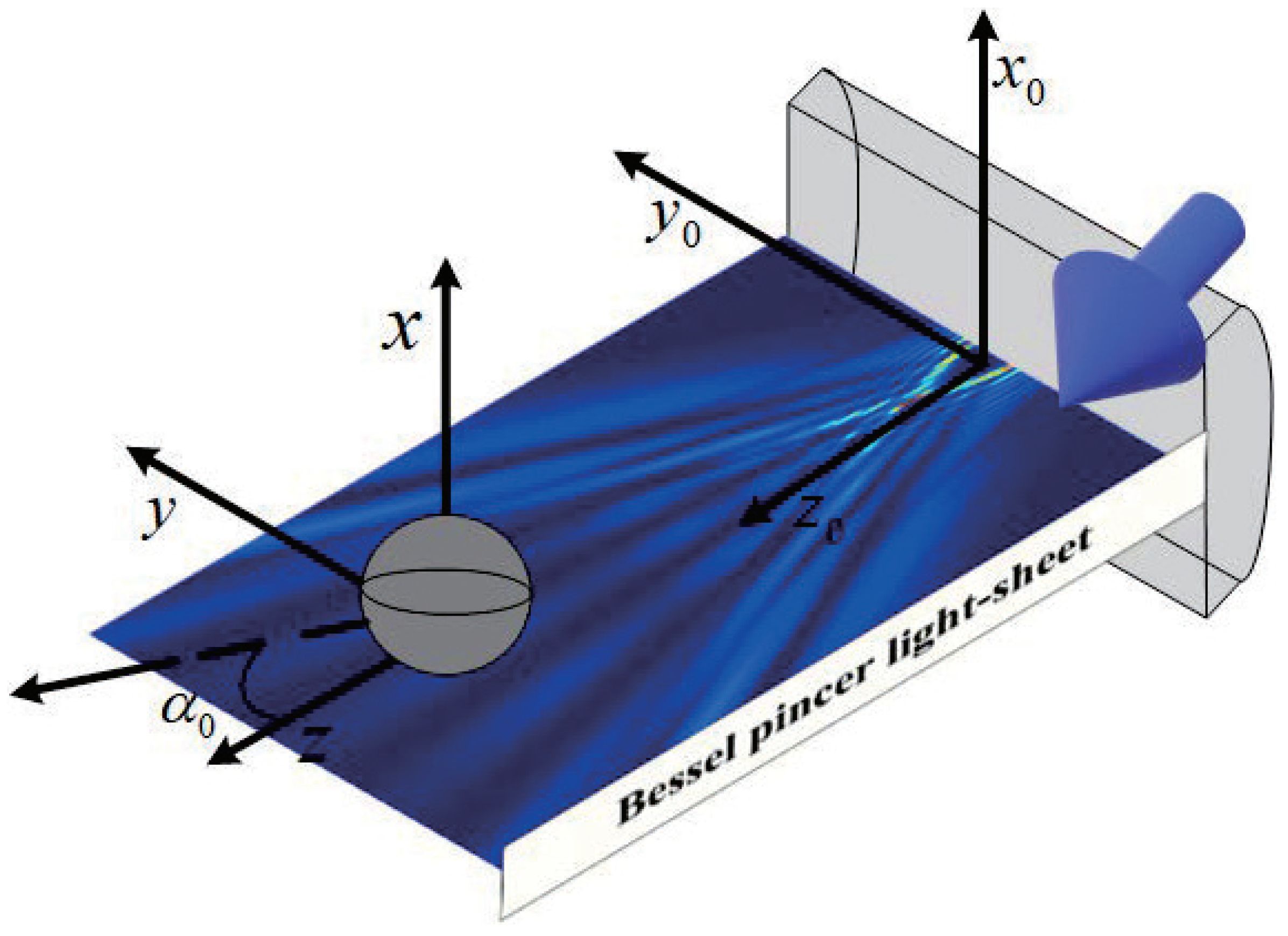
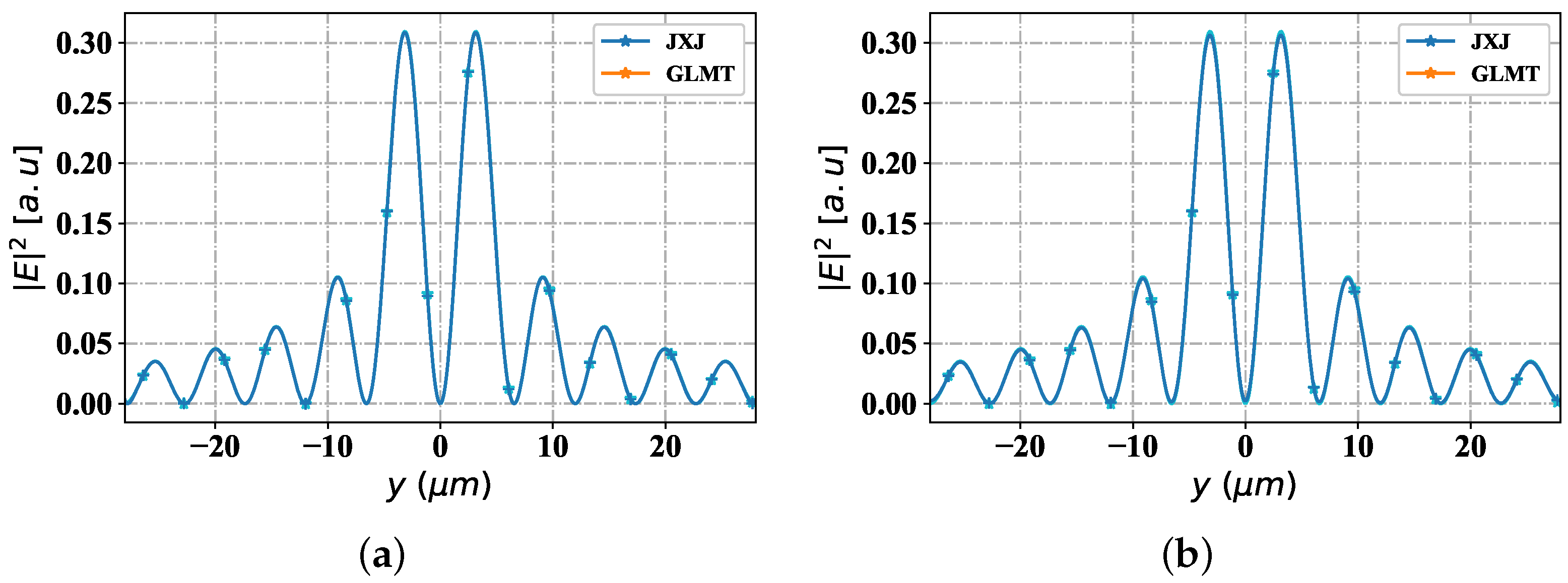
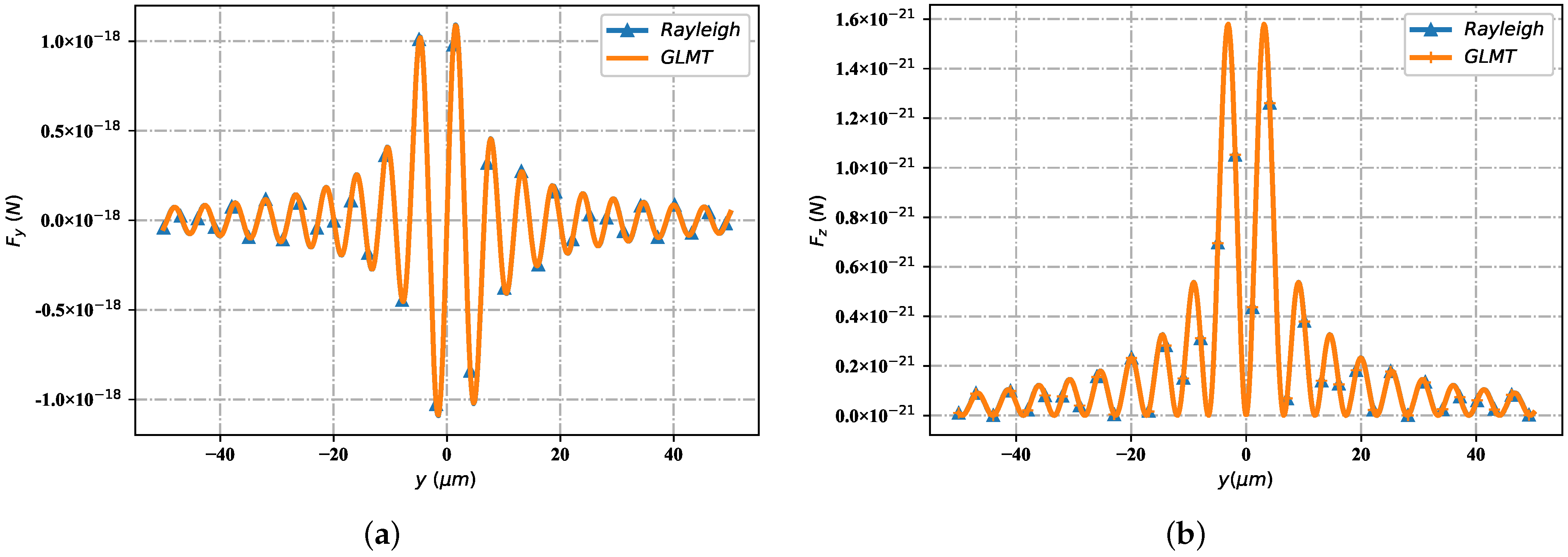

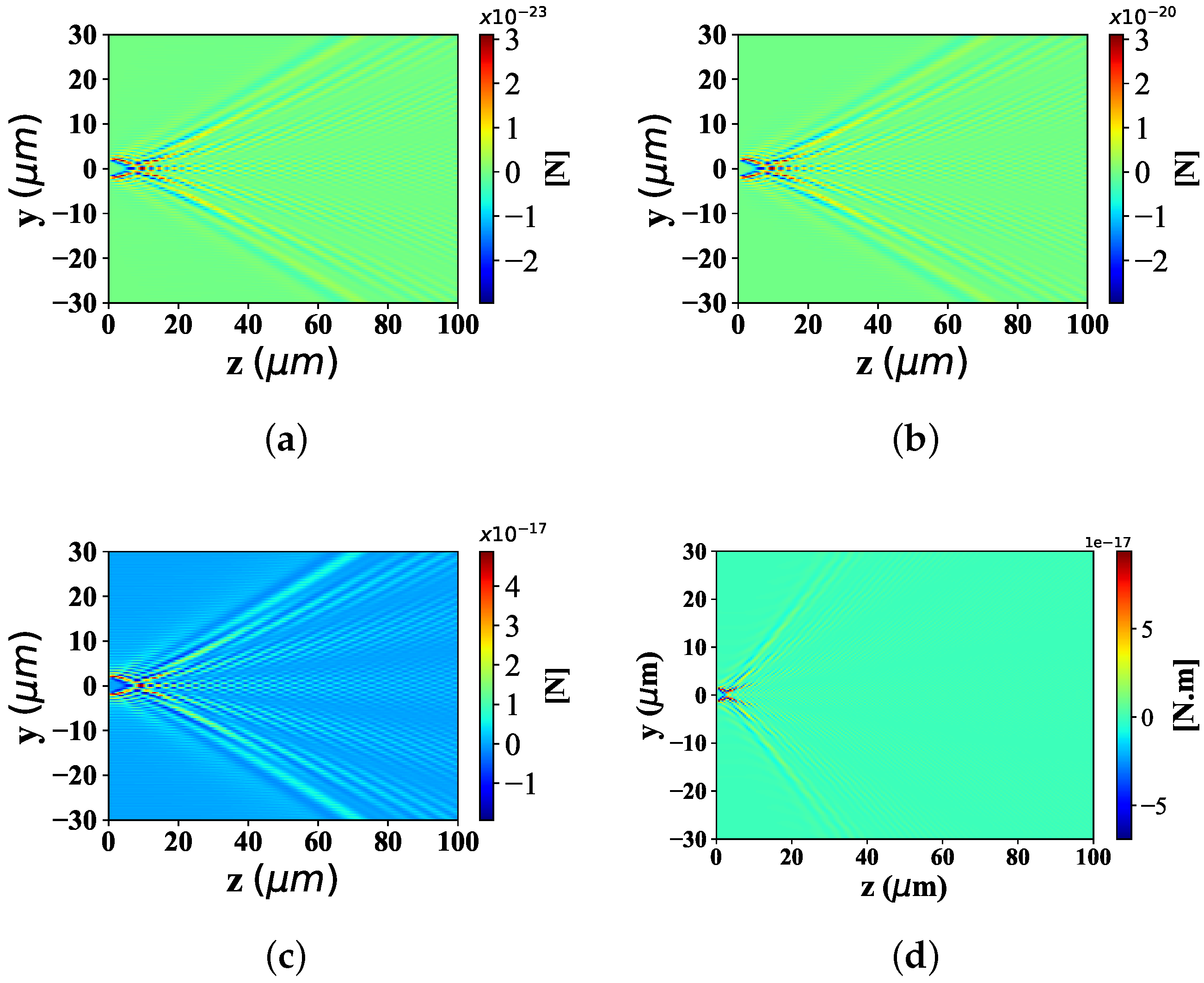




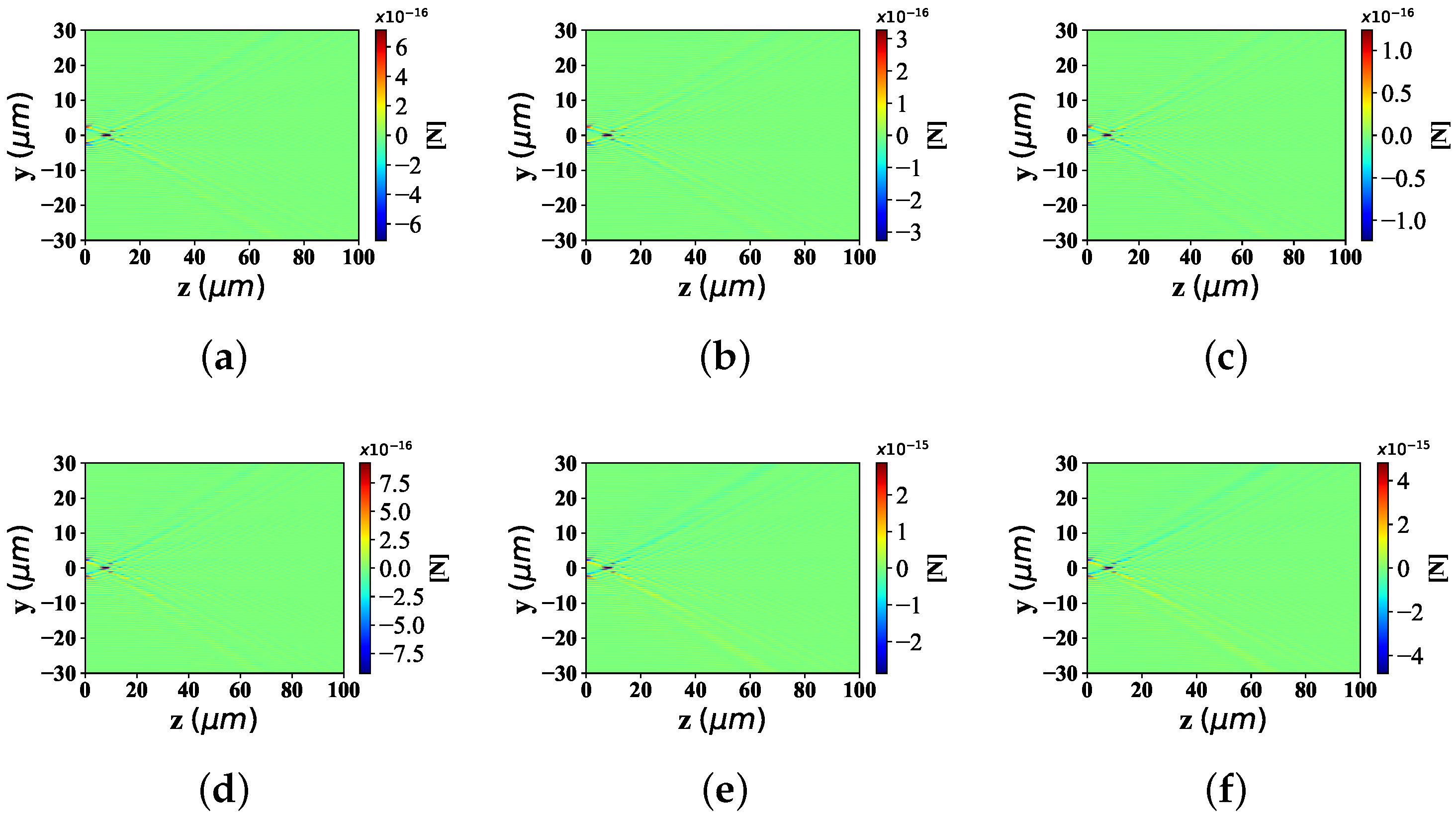
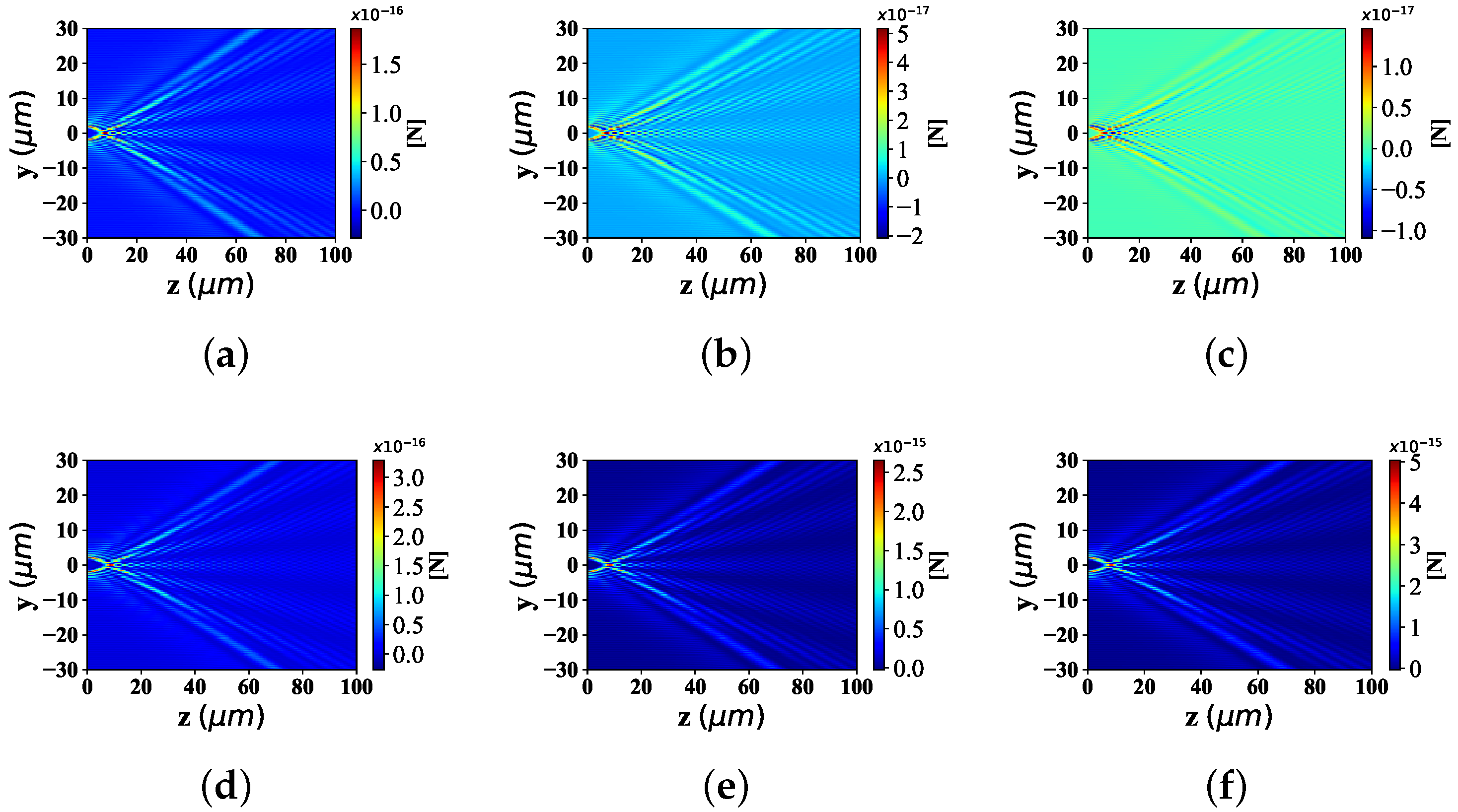

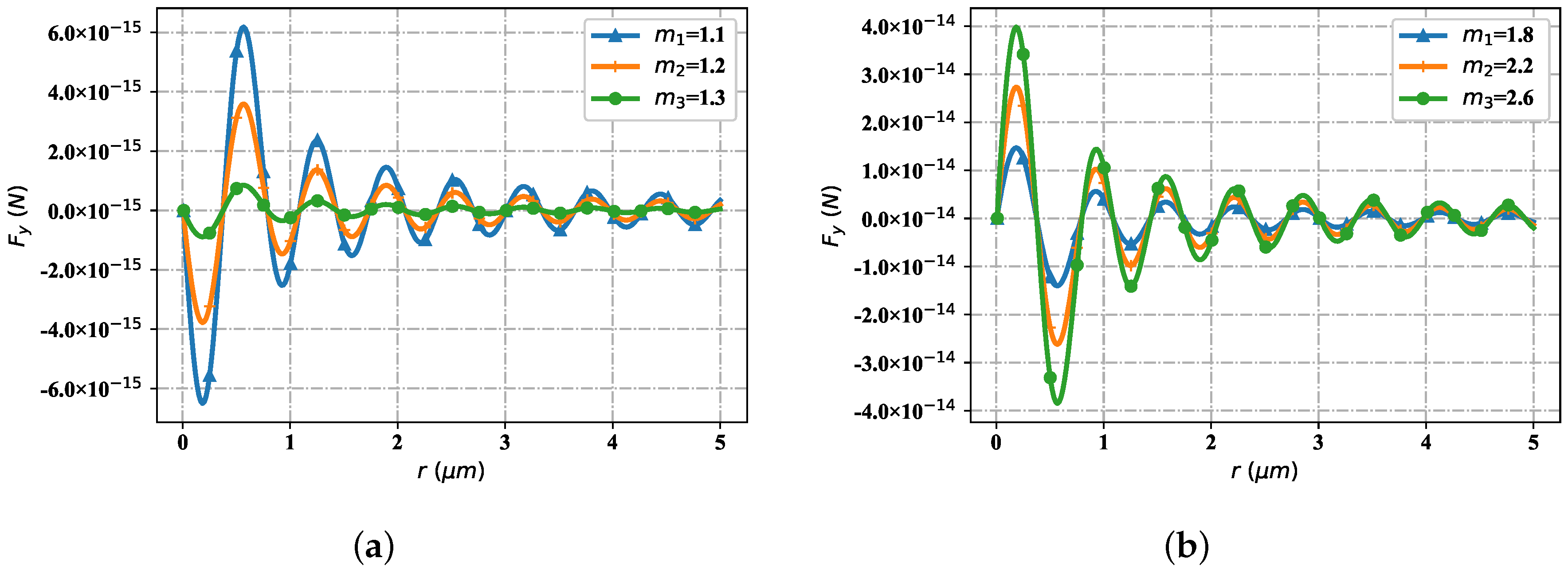
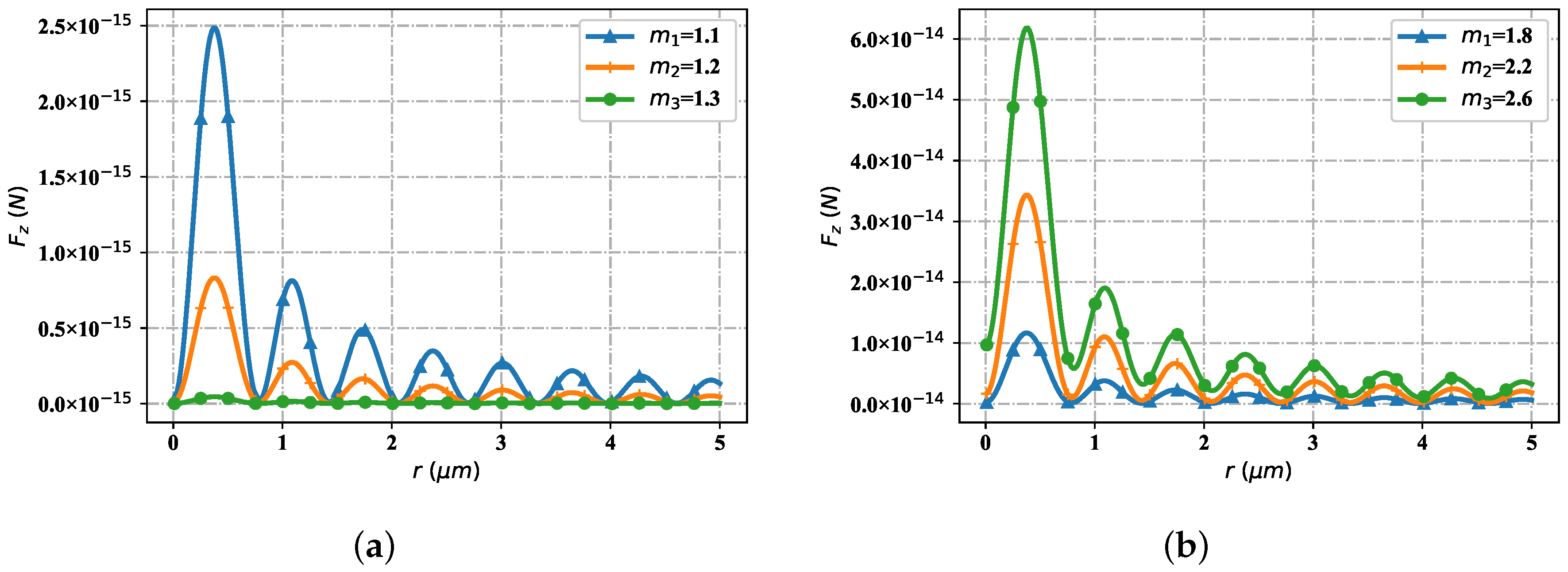
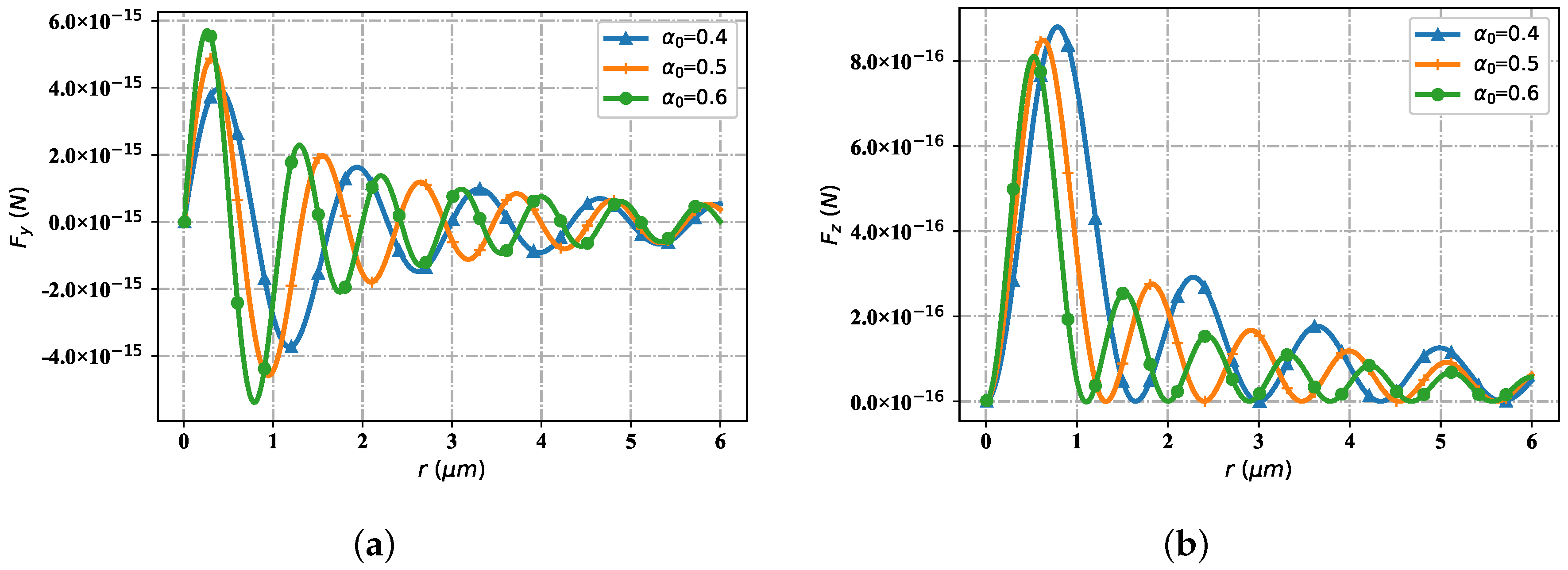
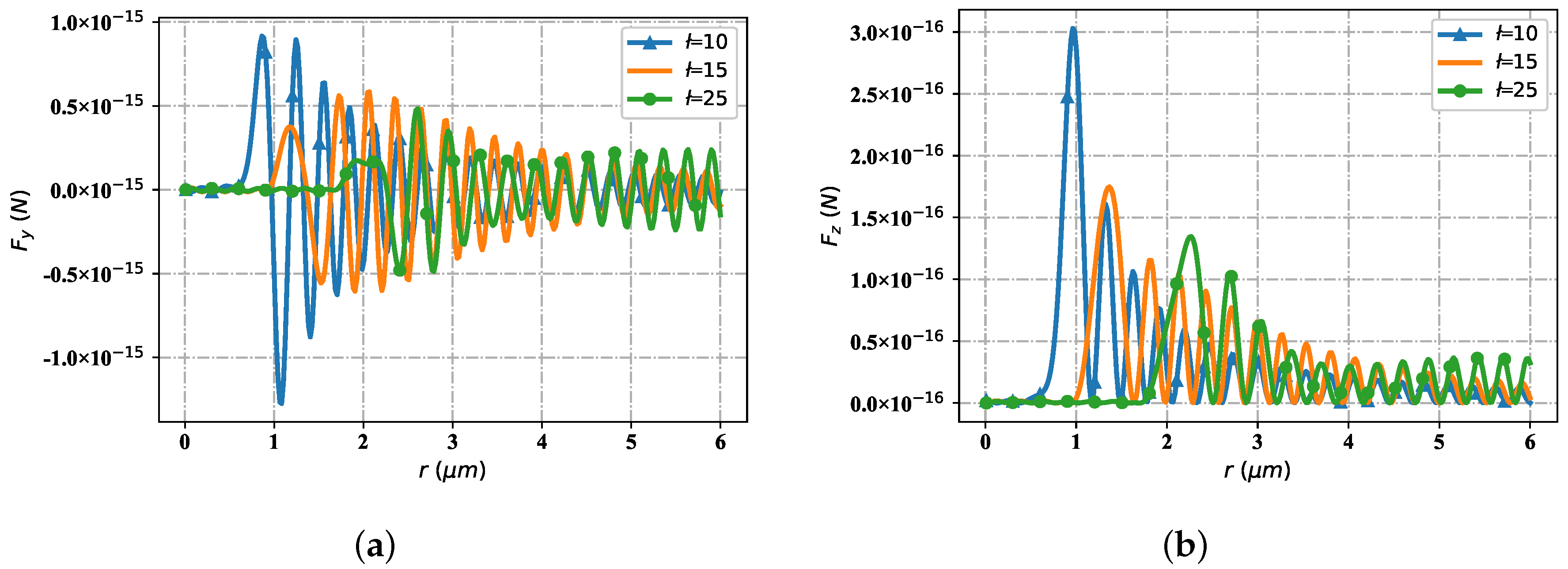
Publisher’s Note: MDPI stays neutral with regard to jurisdictional claims in published maps and institutional affiliations. |
© 2022 by the authors. Licensee MDPI, Basel, Switzerland. This article is an open access article distributed under the terms and conditions of the Creative Commons Attribution (CC BY) license (https://creativecommons.org/licenses/by/4.0/).
Share and Cite
Zhang, S.; Wei, B.; Wei, Q.; Li, R.; Chen, S.; Song, N. Optical Force of Bessel Pincer Light-Sheets Beam on a Dielectric Sphere of Arbitrary Size. Nanomaterials 2022, 12, 3723. https://doi.org/10.3390/nano12213723
Zhang S, Wei B, Wei Q, Li R, Chen S, Song N. Optical Force of Bessel Pincer Light-Sheets Beam on a Dielectric Sphere of Arbitrary Size. Nanomaterials. 2022; 12(21):3723. https://doi.org/10.3390/nano12213723
Chicago/Turabian StyleZhang, Shu, Bing Wei, Qun Wei, Renxian Li, Shiguo Chen, and Ningning Song. 2022. "Optical Force of Bessel Pincer Light-Sheets Beam on a Dielectric Sphere of Arbitrary Size" Nanomaterials 12, no. 21: 3723. https://doi.org/10.3390/nano12213723
APA StyleZhang, S., Wei, B., Wei, Q., Li, R., Chen, S., & Song, N. (2022). Optical Force of Bessel Pincer Light-Sheets Beam on a Dielectric Sphere of Arbitrary Size. Nanomaterials, 12(21), 3723. https://doi.org/10.3390/nano12213723






